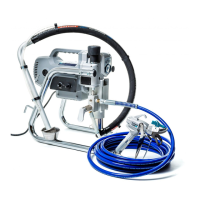PERSONAL SAFETY
+ Stay alert, watch what you are doing and use common sense when operating
an airless sprayer. Do not use while you are tired or under the inuence of
drugs, alcohol, or medication. A moment of inattention while operating airless
sprayers may result in serious personal injury.
+ Use safety equipment. Always wear eye protection. Safety equipment such as
dust mask, non-skid safety shoes, hard hat, or hearing protection used for
appropriate conditions will reduce personal injuries.
+ Avoid accidental starting. Ensure the switch is in the off position before
plugging in.
+ Do not overreach. Keep a proper footing and balance at all times.
This enables better control of the airless sprayer in unexpected situations.
+ Dress properly. Do not wear loose clothing or jewellery. Keep your hair,
clothing and gloves away from moving parts. Loose clothes, jewellery or long
hair can be caught in moving parts.
SERVICE
+ Have your airless sprayer serviced by a qualied repair person using only identical
replacement parts. This will ensure that the safety of the airless sprayer is maintained.
If the supply cord of this airless sprayer is damaged it must be replaced by a
specially prepared cord available through the service organization.
8
QTech QT190 Airless Sprayer
SPECIFIC SAFETY RULES
HANDLE THIS UNIT AS YOU WOULD A LOADED WEAPON!
Extreme high pressure spray can cause extremely serious injury.
OBSERVE ALL WARNINGS
WARNING: HIGH PRESSURE
Never leave pressurized system unattended. Always follow the Pressure Relief
Procedure. Take precautions to avoid high pressure component rupture.
DANGER: INJECTION INJURY
Skin injection by high pressure paint is not a simple cut. It must be treated
surgically immediately.
WARNING: FIRE AND EXPLOSION HAZARD
Take all precautions to avoid sources of sparks and ignition when spraying.
Keep the machine at least 6 meters away from the spraying operation.
WEAR PROTECTIVE EQUIPMENT AT ALL TIMES
Always use a respirator, eye protection and protective clothing. Keep clear of
moving parts when starting or operating the sprayer. Do not put your ngers into
any openings to avoid amputation by moving parts or burns on hot parts.
When starting the motor, maintain a safe distance from moving parts of the
equipment. Before adjusting or servicing any mechanical part of the sprayer,
follow the PRESSURE RELIEF PROCEDURE.
EXPLOSION RISK FROM HALOGENATED HYDROCARBON SOLVENTS
Never use halogenated hydrocarbon solvents in this machine.
Contact with aluminum parts may cause an explosion.
Some of the most common of these solvents are:
Carbontetrachloride
Chlorobenzene
Dichloroethane
Dichloroethyl Ether
Ethylbromide
Ethylchloride
Tethrachloethane
9
Brought to you by Aristospray

